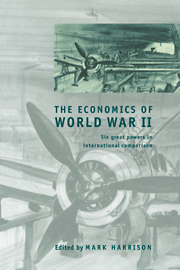Book contents
- Frontmatter
- Contents
- List of figures
- List of tables
- List of contributors
- Preface
- List of abbreviations
- 1 The economics of World War II: an overview
- 2 The United Kingdom: ‘Victory at all costs’
- 3 The United States: from ploughshares to swords
- 4 Germany: guns, butter, and economic miracles
- 5 Italy: how to lose the war and win the peace
- 6 Japan: guns before rice
- 7 The Soviet Union: the defeated victor
- Index
3 - The United States: from ploughshares to swords
Published online by Cambridge University Press: 12 September 2009
- Frontmatter
- Contents
- List of figures
- List of tables
- List of contributors
- Preface
- List of abbreviations
- 1 The economics of World War II: an overview
- 2 The United Kingdom: ‘Victory at all costs’
- 3 The United States: from ploughshares to swords
- 4 Germany: guns, butter, and economic miracles
- 5 Italy: how to lose the war and win the peace
- 6 Japan: guns before rice
- 7 The Soviet Union: the defeated victor
- Index
Summary
Introduction
Between 1939 when World War II began and 1944 when US output reached its wartime peak, the US economy grew at a remarkable rate. Contemporaries described it as a ‘production miracle’. In many ways it was the obverse of the Great Depression. Between 1929 and 1933 real GNP collapsed, shaking the faith of Americans in their economic system; between 1939 and 1944 real GNP rose by an even larger percentage restoring the faith of Americans in their economic system – provided it was given a strong dose of centralized control. The Great Depression was without doubt the most important macroeconomic event of the twentieth century; the mobilization of the American economy in World War II is a close second. Yet the economic history of the Great Depression has been studied in great depth, while World War II remains comparatively unknown.
This chapter is concerned mainly with three questions about the war economy. First, where did the United States find the resources it needed? Second, how was this effort financed? Third, what were the long-run economic consequences? The chapter argues that the answers traditionally given to these questions need to be modified. To take the first question for example, there is a tendency when explaining the growth of real output to focus on a single factor, usually the high level of unemployment prevailing before the war, or the entry of more women into the labour force.
- Type
- Chapter
- Information
- The Economics of World War IISix Great Powers in International Comparison, pp. 81 - 121Publisher: Cambridge University PressPrint publication year: 1998
- 18
- Cited by



